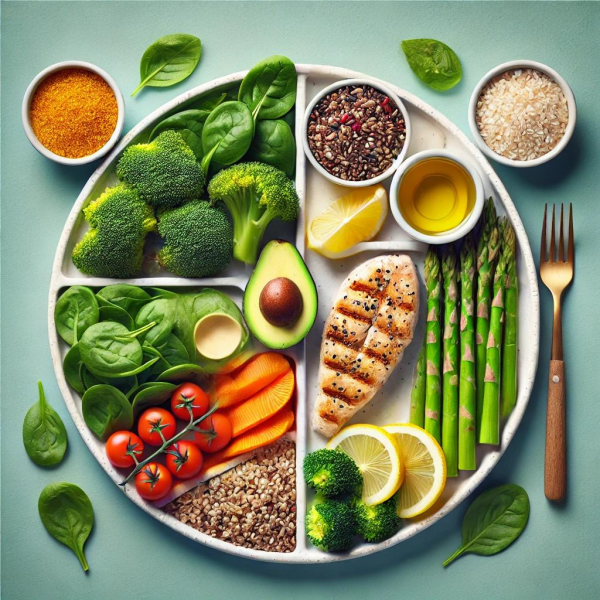Best Food for Diabetes Control
Top Foods to Manage and Control Diabetes Effectively

Introduction
Managing diabetes effectively involves more than just medication and regular check-ups; it’s also about making smart dietary choices. Consuming the right foods can help control blood sugar levels, maintain a healthy weight, and prevent complications. Here, we’ll explore some of the best foods for diabetes control that you can incorporate into your daily diet.

Non-Starchy Vegetables
Non-starchy vegetables are low in calories and carbohydrates, making them an excellent choice for diabetes management. They are rich in vitamins, minerals, and fiber, which help in maintaining blood sugar levels.
- Leafy Greens: Spinach, kale, and Swiss chard are nutrient-dense and have minimal impact on blood sugar.
- Cruciferous Vegetables: Broccoli, cauliflower, and Brussels sprouts are high in fiber and antioxidants.
- Bell Peppers: These are low in carbs and high in vitamins A and C.
Whole Grains
Unlike refined grains, whole grains contain the entire grain kernel, providing more fiber, vitamins, and minerals. They have a lower glycemic index, meaning they cause a slower rise in blood sugar levels.
- Oats: A good source of soluble fiber that can help control blood sugar.
- Quinoa: Rich in protein and fiber, making it a great substitute for refined grains.
- Brown Rice: Contains more fiber and nutrients compared to white rice.
Lean Proteins
Protein is essential for muscle repair and overall health. Choosing lean protein sources can help manage weight and blood sugar levels.
- Chicken and Turkey: Skinless poultry is lower in fat and calories.
- Fish: Fatty fish like salmon, mackerel, and sardines are high in omega-3 fatty acids, which are beneficial for heart health.
- Legumes: Beans, lentils, and chickpeas are high in protein and fiber, making them great meat substitutes.
Healthy Fats
Healthy fats can improve insulin sensitivity and provide long-lasting energy. It’s important to choose unsaturated fats over saturated and trans fats.
- Avocado: Packed with monounsaturated fats and fiber.
- Nuts and Seeds: Almonds, walnuts, chia seeds, and flaxseeds are excellent sources of healthy fats and protein.
- Olive Oil: A heart-healthy oil that can be used in cooking and dressings.
Fruits
While some fruits are high in sugar, others have a lower glycemic index and can be enjoyed in moderation. They provide essential vitamins, minerals, and fiber.
- Berries: Strawberries, blueberries, and raspberries are low in sugar and high in fiber.
- Citrus Fruits: Oranges, lemons, and grapefruits are high in vitamin C and fiber.
- Apples: Contain soluble fiber and can be eaten with the skin for added nutrients.
Dairy
Choosing low-fat or non-fat dairy products can help reduce calorie intake while providing important nutrients like calcium and vitamin D.
- Greek Yogurt: High in protein and probiotics, which are good for gut health.
- Cottage Cheese: A low-fat option that’s high in protein.
- Milk: Opt for low-fat or skim milk to reduce calorie and fat intake.
Incorporating These Foods into Your Diet
Incorporating these diabetes-friendly foods into your diet doesn’t have to be complicated. Here are some tips to help you get started:
- Meal Planning: Plan your meals ahead of time to ensure they include a balance of carbohydrates, proteins, and fats.
- Portion Control: Be mindful of portion sizes to avoid overeating.
- Healthy Snacks: Choose healthy snacks like nuts, seeds, and fresh vegetables to keep blood sugar levels stable between meals.
- Cooking Methods: Opt for grilling, baking, or steaming instead of frying to reduce unhealthy fat intake.

Conclusion
Eating a balanced diet rich in non-starchy vegetables, whole grains, lean proteins, healthy fats, fruits, and low-fat dairy can help manage diabetes effectively. At Apollo Sugar Clinics, we are dedicated to providing comprehensive care and support to help you maintain a healthy lifestyle. Incorporate these foods into your daily routine to take control of your diabetes and improve your overall health.
F.A.Q

Foods that are low in carbohydrates and high in fiber, vitamins, and minerals are ideal for managing diabetes. Some of the best options include:
- Non-Starchy Vegetables: Spinach, kale, broccoli, bell peppers.
- Whole Grains: Quinoa, brown rice, oats.
- Lean Proteins: Skinless chicken, fish, legumes.
- Healthy Fats: Avocados, nuts, seeds, olive oil.
- Low-Glycemic Fruits: Berries, citrus fruits, apples.
- Low-Fat Dairy: Greek yogurt, cottage cheese, low-fat milk.
Whole grains have a lower glycemic index compared to refined grains, which means they cause a slower rise in blood sugar levels. They are also rich in fiber, which helps improve digestion and keeps you feeling full longer, aiding in weight management.
Yes, you can eat fruits, but it’s important to choose low-glycemic options that won’t spike your blood sugar levels. Berries, citrus fruits, and apples are good choices. Always consume fruits in moderation and monitor your blood sugar levels to see how they affect you.
Lean proteins are low in unhealthy fats and help in building and repairing tissues without causing significant blood sugar spikes. They also help keep you full longer, which can prevent overeating and help maintain a healthy weight.
Healthy fats, such as those found in avocados, nuts, seeds, and olive oil, can improve insulin sensitivity and provide long-lasting energy. They help reduce inflammation and lower the risk of heart disease, which is important for people with diabetes.
- Meal Planning: Prepare meals ahead of time to ensure a balanced intake of nutrients.
- Portion Control: Be mindful of portion sizes to avoid overeating.
- Healthy Snacks: Choose snacks like nuts, seeds, and fresh vegetables.
- Cooking Methods: Use healthier cooking methods like grilling, baking, or steaming instead of frying.
